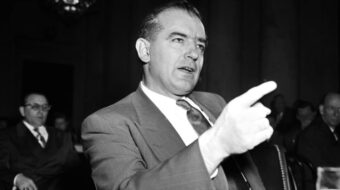
WASHINGTON—Seventy years after the U.S. Supreme Court unanimously outlawed segregation and “separate but equal”—which wasn’t equal—in its landmark Brown v Board of Education decision, are the court and parts of the country going backwards?
The answer seems to be “yes.” Of course, as a spate of books, exhibits, podcasts, and teaching materials, including from the nation’s largest union, the National Education Association, note, actually much of the nation never accepted equality under the law for Blacks or any other minority.
Which means, NEA says, that the struggle for equality continues.
The reflections roll around as does the 70th anniversary of the High Court’s ruling. On May 17, 1954, led by Chief Justice Earl Warren, who had to lobby several of his colleagues—and make one key compromise—to achieve unanimity, the justices declared segregation in schools, and by extension in society, unconstitutional. The point: Eliminate Jim Crow.
The justices ordered dismantling of its structures, in a landmark lawsuit brought by the NAACP, and argued by its chief counsel, Thurgood Marshall, who later became the court’s first African-American justice.
“Where you see wrong or inequality or injustice, speak out, because this is your country. This is your democracy. Make it. Protect it. Pass it on,” Marshall later said. His quote leads the NEA’s teaching unit on the Brown case and afterwards.
But changing hearts and minds isn’t as easy as changing laws.
Indeed, just over a year later, the court had to revisit the issue, due to massive Southern resistance to its Brown ruling. Its follow-up decision ordered desegregation to occur “with all deliberate speed.” But resistance continued, South and North.
It’s never stopped
Indeed, you could argue it’s never stopped—and that white nationalists continue to push it, and to expand prejudice from hate of Blacks to hate of other minorities, women, and workers as well.
Remember the John Birch Society’s “Impeach Earl Warren” signs of the 1950s. And “massive resistance”—closure of all public schools to prevent integration—in Virginia for a decade after Brown. For that matter, remember the 1896 Plessy v Ferguson ruling, legalizing “separate but equal” which Warren’s court overturned in Brown.
Remember the rocks and bricks whites in the Chicago suburb of Cicero threw at Dr. Martin Luther King and his marchers for housing desegregation there in the 1960s and King’s murder by white nationalist James Earl Ray in 1968.
Recall Richard Nixon’s “Southern Strategy” appealing to the racists to win the White House that year. That was the genesis of today’s Trumpite Republican Party, dominated by philosophical descendants of the Southern racists. The “Party of Lincoln” has become the party of Lincoln’s enemies.
The 1968 Fair Housing Act was supposed to outlaw housing discrimination and redlining. But the U.S. is just as residentially segregated now as it was in 1954 or 1968. In some metro areas, thanks to realtors taking advantage of “white flight”—or pushing it—that segregation has increased.
Recall controversies over school busing to achieve desegregation in Boston, Louisville, Ky., California and throughout the South. And politicians—Joe Biden included—pandering to that racism through anti-busing and “tough on crime” legislation, an attitude that Biden for one has long since repented. But that the Southerners who now run the Republican Party have not.
Fast forward to the present years, when racism again emerged from the closet, while trying to push Blacks, gays, Jews, women, Spanish-speaking people, and, yes, workers, back in it.
Neo-Nazis paraded through Charlottesville, Va., in 2017, demanding the preservation of a statue of Confederate Gen. Robert E. Lee, and chanting against Jews. Donald Trump called the neo-Nazis—one of whom fatally hit and killed peaceful counter-protester Heather Heyer with his car, “very fine people.”
Meanwhile, the justices, fueled by Republican-named right-wingers, dismantled the Voting Rights Act, denied workers’ rights, liberated the “right to work” movement for all public workers, and dismantled their prior ruling allowing race to be used as a factor in achieving fairness in college admissions.
The current court also refused to outlaw state gerrymandering of legislative and congressional districts unless it’s obviously racist and sponsors admit it and—as the capper—removed a woman’s right to abortion and control of her own body.
And just days before the 70th anniversary of Brown, school boards in two rural Virginia counties restored their former memorialization of Confederate generals in the names of two public schools.
The prior board dropped the rebels’ names during the national Black Lives Matter movement. But a so-called citizens group demanded the restoration of the Confederate memorialization, even though a majority of speakers—50 out of 80—at one school board’s session opposed the reversal. No wonder the NEA, and they’re not alone, is alarmed.
Since the ruling, it’s been 70 years
“It’s been 70 years since the U.S. Supreme Court issued its landmark ruling in Brown v. Board of Education. For many, this iconic Supreme Court case feels like a foundational and permanent part of American society, but today, the promises of Brown v. Board are under attack,” union staff counsel Danielle Davis says in a podcast, part of NEA’s Brown v Board at 70 teaching unit.

Brown “also ignited mass resistance that continues today through policies that drive segregation and racial inequities,” the teaching unit continues. It then describes “how educators, unions, and allies continue to help achieve integration and equitable outcomes for all students.”
Michael Bobelian, author of a book on Chief Justice Earl Warren and the social revolution his Supreme Court’s rulings, particularly Brown, fostered, argues the Warren Court was an exception to what has otherwise been a rather sorry judicial record of upholding racism and segregation.
That record stretches all the way back to converting the Constitution’s 14th Amendment to guarding corporate and property rights and Jim Crow, he says. The amendment’s authors intended it to free Blacks from slavery and its after-effects. Then that court overturned post-Civil War civil rights laws.
“Large segments of the population had no access to the ballot and many more lived in warped legislative districts reminiscent of Britain’s rotten boroughs.,” Bobelian said in a recent essay.
“Warren’s 16 years at the helm upended the court’s disgraceful record. In cases involving McCarthyism, due process for defendants, privacy, free speech, the separation of church and state, and a range of other civil and political rights, he transformed the institution into a consistent force for equality and liberty for the first and only time in its history.
“As one of nine justices, Warren didn’t act alone. A series of liberal jurists—some legends in their own right–such as Hugo Black, William O. Douglas, Arthur Goldberg, Abe Fortas, Thurgood Marshall, and most notably, William J. Brennan, Warren’s closest colleague and principal lieutenant on the bench, played key roles on the Warren Court.
“Without the chief justice at the helm, however, it would have been difficult for the court to achieve such historical renown.”
Black symbolized the turnabout. Before joining the court as an FDR appointee, he was a Southern Democratic senator from Alabama, going along with regional racism. But starting in 1941, he became a staunch defender of free speech and other civil rights. Biographers have mentioned Black’s great emotional struggles preceding his turnabout.
Goldberg, who had been chief counsel for the Steelworkers and JFK’s first Labor Secretary, defended minorities and workers for years before joining the bench. LBJ nominated Marshall to the High Court.
But, sad to say, the current court has no Earl Warren, no William J. Brennan, and no Hugo Black. And the justices who could fill those roles, such as Sonia Sotomayor and Ketanji Brown Jackson—the tribunal’s first Hispanic-American justice and first Black woman justice, respectively–are in the minority.
And this court has been reversing women’s rights, workers’ rights, gerrymandering, except when it’s obviously racially motivated, and, most importantly, voting rights, especially for people of color.
We hope you appreciated this article. At People’s World, we believe news and information should be free and accessible to all, but we need your help. Our journalism is free of corporate influence and paywalls because we are totally reader-supported. Only you, our readers and supporters, make this possible. If you enjoy reading People’s World and the stories we bring you, please support our work by donating or becoming a monthly sustainer today. Thank you!










